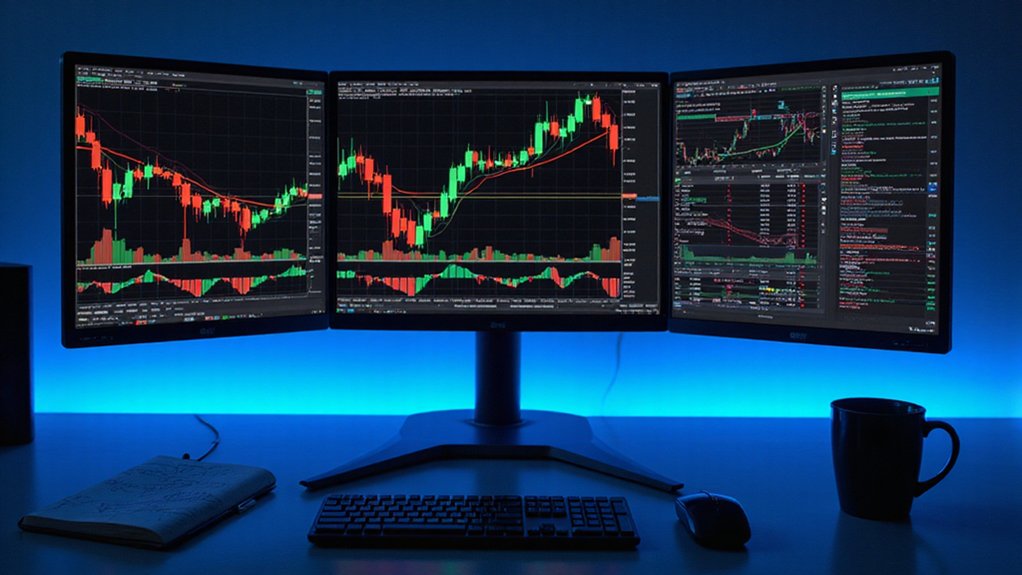Bitcoin’s market cap stands at a staggering $1.87 trillion as of late April 2025—representing 61% of the entire cryptocurrency ecosystem. This decentralized financial behemoth (operating without CEO, headquarters, or marketing department) has achieved nearly 50% year-over-year growth from its previous $1.26 trillion valuation. With only 19.8 million of its capped 21 million coins in circulation, Bitcoin’s scarcity principle continues to underpin its value proposition despite the persistent volatility that accompanies its ascent.

The colossal $1.87 trillion valuation that Bitcoin commands as of late April 2025 represents not merely a number on a digital ledger but rather the culmination of a remarkable economic experiment that has transformed from cypherpunk curiosity to financial juggernaut.
This figure—calculated simply as the circulating supply of 19.8 million coins multiplied by the current price per BTC—places the cryptocurrency firmly atop the digital asset hierarchy, comprising a dominant 61% of the entire $3.09 trillion crypto ecosystem.
One might reasonably ask how a network with no CEO, no headquarters, and no marketing department came to be valued higher than most Fortune 500 companies combined.
A decentralized network commanding more economic value than corporate giants defies traditional market logic yet defines Bitcoin’s unprecedented rise.
The journey to this astronomical market capitalization wasn’t linear.
Bitcoin first surpassed the trillion-dollar threshold in 2021, experiencing characteristic volatility before ascending to its current heights.
What began as a technical whitepaper has manifested as the world’s premier scarce digital asset, with just 1.2 million coins remaining to be mined before hitting the immutable cap of 21 million.
This mathematical certainty of scarcity—quite unlike the elastic money supply of fiat currencies—underpins much of Bitcoin’s perceived value proposition.
Daily trading volume of approximately $28 billion reinforces Bitcoin’s position, providing liquidity that institutional players once deemed insufficient but now embrace as adequate for significant capital deployment.
The market cap metric itself serves multiple purposes beyond mere valuation; investors leverage it to gauge relative stability, assess portfolio allocation parameters, and benchmark against traditional asset classes.
When Bitcoin’s dominance ratio fluctuates, market participants scrutinize these movements for signals of capital rotation between Bitcoin and the altcoin sphere.
The progression from $1.26 trillion just twelve months ago to today’s $1.87 trillion valuation reflects broader economic narratives—institutional adoption accelerating, regulatory frameworks maturing, and investor perception evolving. Unlike competitors such as Ethereum and Solana which focus on transaction speeds, Bitcoin’s primary value proposition remains its position as digital gold. The impressive 49.79% increase year-over-year demonstrates Bitcoin’s continued momentum despite short-term fluctuations in the market.
As Bitcoin’s market cap continues its upward trajectory (punctuated by inevitable corrections), what was once dismissed as speculative mania increasingly resembles a legitimate, if still experimental, financial paradigm.
It’s worth noting that this meteoric rise comes with substantial investment risk, as crypto-assets remain highly volatile and can experience rapid value drops with potential for total loss of invested capital.
Frequently Asked Questions
How Does Bitcoin’s Market Cap Compare to Gold?
Bitcoin’s market cap ($1.86 trillion) remains substantially smaller than gold’s estimated $7-10 trillion valuation—a David-and-Goliath scenario in the asset world.
While Bitcoin has achieved remarkable growth to become the fifth-largest global asset, it still represents only about 20-25% of gold’s market capitalization.
This gap, however, continues to narrow as Bitcoin gains institutional acceptance and demonstrates its unique value proposition as digital scarcity in an increasingly virtual economic landscape.
What Causes Sudden Drops in Bitcoin’s Market Cap?
Sudden drops in Bitcoin’s market cap result from a perfect storm of market dynamics: regulatory crackdowns, whale sell-offs, and investor panic often converge to create precipitous declines.
The cryptocurrency’s notorious volatility—amplified by social media’s echo chambers and algorithmic trading—means news (or mere rumors) can trigger avalanche-like sell-offs.
Macroeconomic shifts play their part too, as Bitcoin hasn’t quite shed its reputation as the first asset institutions jettison when economic uncertainty looms.
Can Bitcoin’s Market Cap Reach $1 Trillion?
Bitcoin’s market cap has already exceeded $1 trillion—currently hovering around $1.86 trillion as the fifth-largest global asset.
The question isn’t whether it can reach this milestone (a threshold crossed in previous cycles) but rather if it can sustain and build upon this valuation.
With ARK projecting potential prices between $300,000 and $1.5 million by 2030, Bitcoin’s future market cap could reach stratospheric levels, despite the inherent volatility that periodically rattles investor confidence.
Is Market Cap the Best Measure of Bitcoin’s Value?
Market capitalization, while convenient and widely referenced, falls short as bitcoin’s definitive value metric.
This simplistic calculation (circulating supply × price) overlooks critical factors including liquidity constraints, dormant coins, network utility, and technological development milestones.
More nuanced evaluation requires a multidimensional approach incorporating on-chain analytics, adoption metrics, and infrastructure development.
The fact that market cap reached $1 trillion—a milestone discussed previously—merely represents a psychological threshold rather than an intrinsic achievement in bitcoin’s evolving narrative as digital infrastructure.
How Does Bitcoin’s Market Cap Affect Altcoin Valuations?
Bitcoin’s market cap exerts considerable influence over altcoin valuations through multiple mechanisms.
As the crypto flagship, Bitcoin’s price movements typically trigger corresponding shifts in altcoin prices—a phenomenon crypto traders call “riding Bitcoin’s coattails.”
This correlation stems from Bitcoin’s dominance ratio and market sentiment spillover effects.
When Bitcoin surges, investor confidence permeates the broader crypto ecosystem; conversely, Bitcoin downturns often precipitate more dramatic altcoin selloffs due to their comparatively smaller market caps and heightened volatility profiles.









